Understanding Japanese Train Etiquette
You feel more comfortable and confident traveling on Japanese trains when you understand some of the etiquette. No one expects perfection.
by Bob Kerstetter
Train Types Summary
Four types of trains carry millions of people daily throughout Japan. In sequence by least-to-most amount of stops they make between termination locations, the train types are: Rapid Express, Express, Limited Express and Local. Some rail lines add more types—sometimes naming them for specific destinations—but these four carry most local rail traffic. For more about traveling inside Japan, see our article on Moving Around Japan.
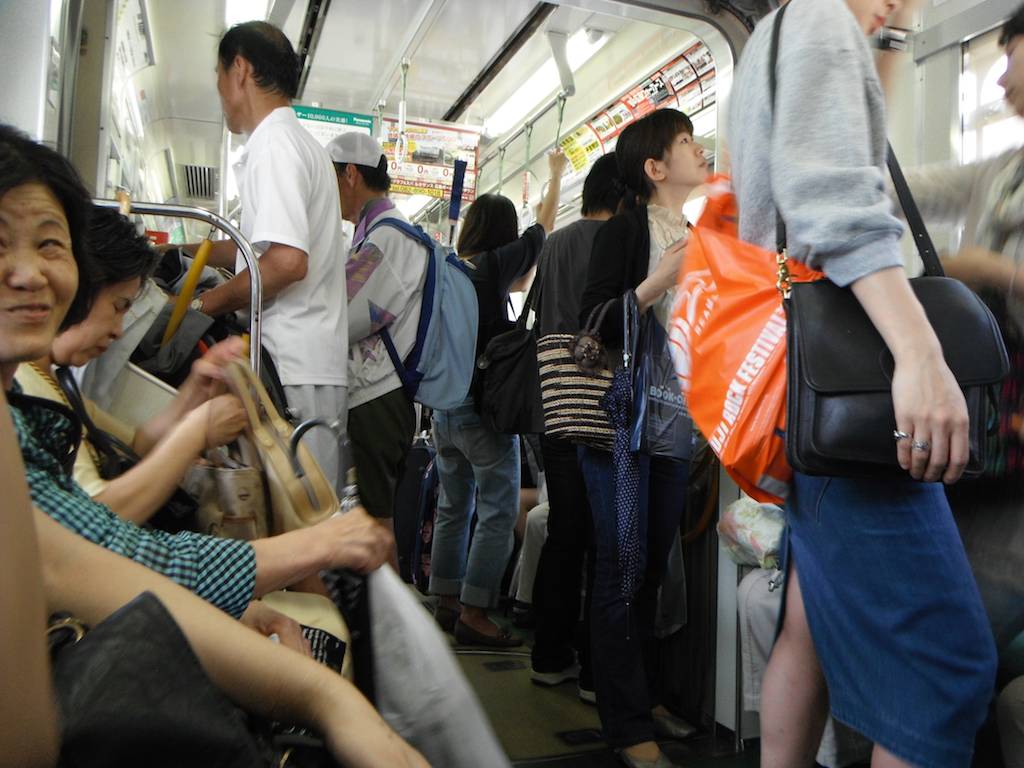
Trains fill to standing room only capacity on a summer day afternoon in Hiroshima. They remain orderly and clean because of train etiquette.
To enjoy your time in Japan, learn about where your train stops by reading the timetables available in every train station. This is very important, because while a Rapid Express makes the fastest trips, it may not stop at your destination. Ask someone for help if you experience trouble reading the schedules. When seeking assistance from a train station employee working at a gate, you may need to wait in line.
Some trains divide at a designated stop along their routes. For instance, a train from Osaka to Wakayama begins with six cars. It later splits into two three-car units with one traveling to Wakayama City and the other running to Kansai International Airport. They relink on their return trip. You benefit by knowing which cars go to your destination. If you enter a wrong car, you can always change before the split occurs—more than adequately announced—by using the doors at each end of each car.
In addition to local trains, some cities provide subways, street cars, trollies and trams. Cross country travelers can also ride the Shinkansen—high speed bullet trains—our favorite means to travel Japan—fast, but still slow enough for you to see the more distant countryside. Again, check schedules and stops before selecting trains.
Waiting For, Boarding, Riding and Exiting Trains
Japanese trains run on time. If you run late for your train, you can count on missing your ride. Arrive at the train station early. Japanese trains wait for no one.
When waiting for your train to arrive, stay behind the wide white or yellow textured line marking the safety zone. When the time for your train approaches stand in line where a train door opens. Every station marks door positions on the train platform floor. How you stand in line varies with location.
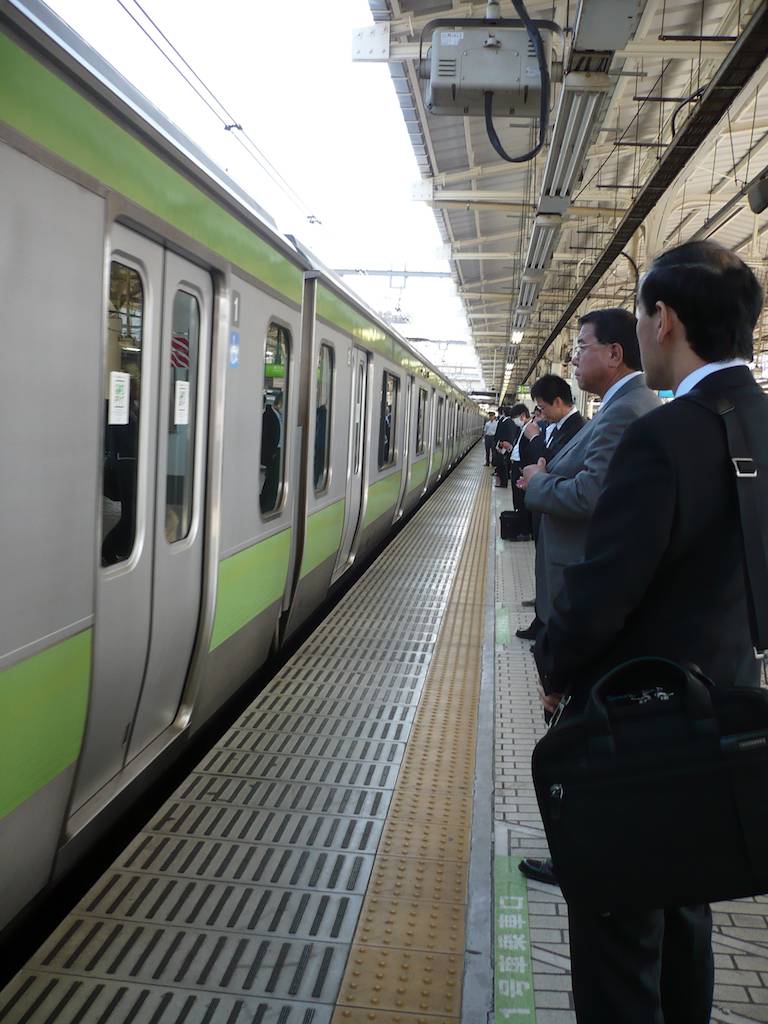
Japanese businessmen stay behind the yellow textured line marking the safety zone.
Sometimes you stand in two lines, one on either side of the door. Other times you stand in one line and move to the side when the train door opens. Watch what other people do and follow their lead. Either method clears the space in front of the door for passengers departing the train.
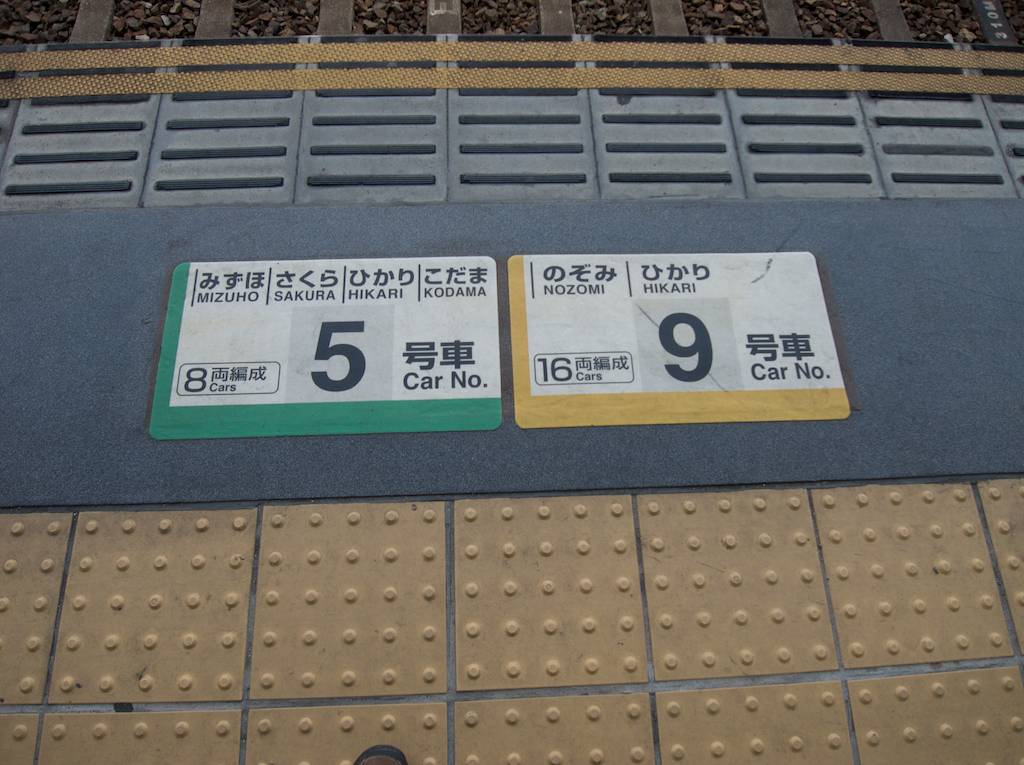
Almost every train station in Japan marks door positions on the platform floor showing where trains stop.
When you enter the train, get on quickly. During rush hour at some very crowded stations train company employs may push you to aid your rapid entry. Once inside continue to move as far as you can from the door. This helps keep the door clear for people to enter and exit.
Give up your ideal of personal space when riding crowded trains in Japanese cities. You often stand or sit in very close proximity to your neighbors. Most Japanese people keep themselves clean. They often wear surgical-style masks in public to keep from spreading germs.
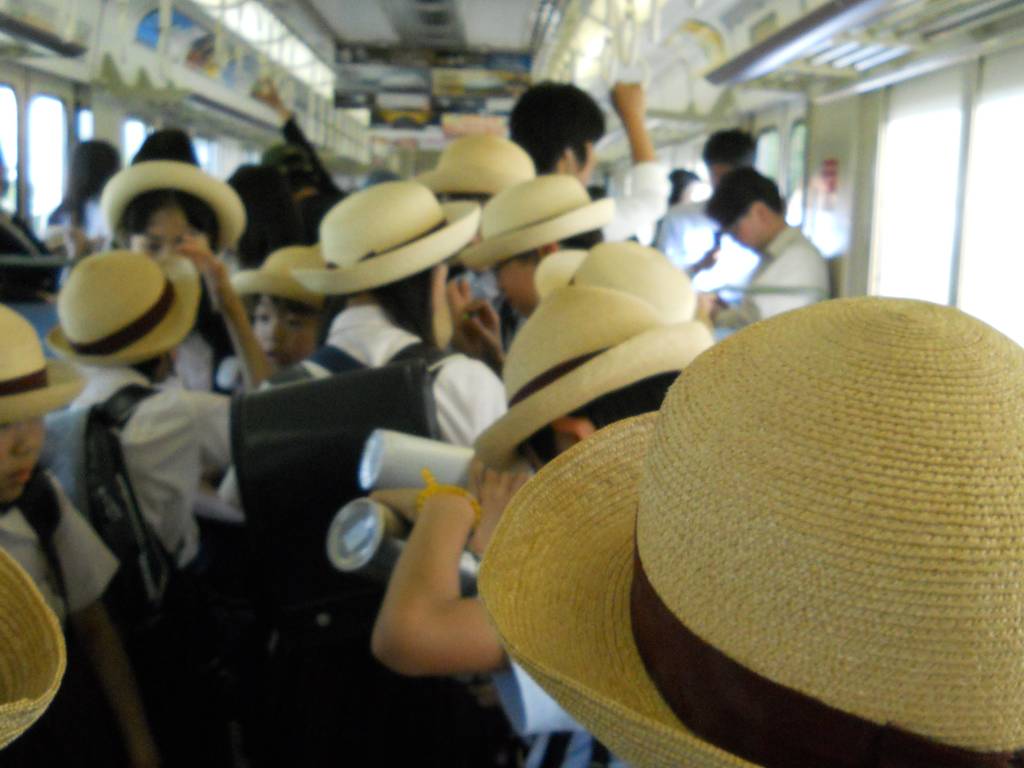
In between rush hours, school children sometimes fill up a train car. You must discard your idea of personal space when riding Japanese commuter trains.
Use overhead handhold rings if you are standing. They help you steady yourself while the train moves, especially during acceleration and deceleration.
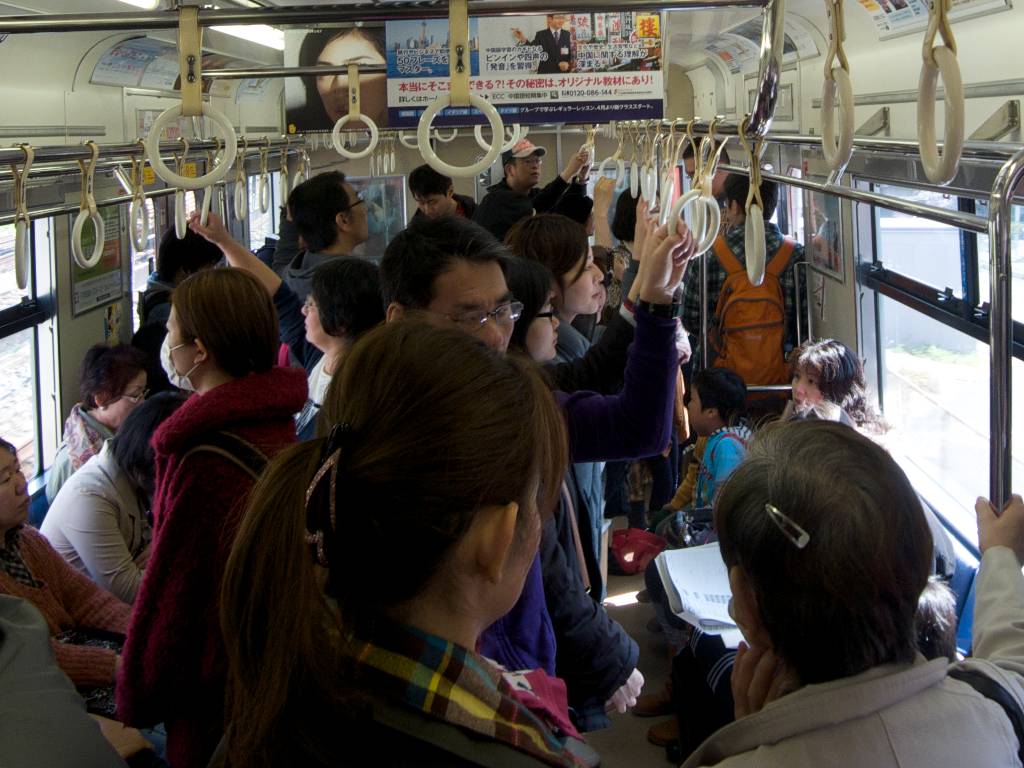
Passengers use overhead handholds when standing on crowded Japanese commuter trains.
The train announces each exit—sometimes in Japanese, sometimes in both Japanese and English. Start to move toward the door when you hear your exit name. Say sumimasen—excuse me please—while moving, but keep inching forward without shoving. People squeeze together to let you through. No one thinks of you as rude for exiting the train. Make sure you move aside when someone else needs to exit around you. Exit the train quickly, moving away from the door to clear the space for others.
On cross country trains you almost always enjoy a seat, often a reserved seat. For these trains, enter quickly, find your seat, store your luggage in the overhead rack and sit down. When your exit nears, stand up, retrieve your luggage and walk to the exit nearest you. Trust the announcement when it says the train plans to make a brief stop. Be ready to exit quickly, moving away from the door to clear it for others.
Priority Seating
Most local train cars reserve space called priority seating for travelers with special needs—including pregnant, elderly and physically disabled passengers. You can sit in these locations until you see someone who qualifies for the seat.
With all priority seating filled, giving your regular seat to someone in need shows respect for the person, a quality valued in Japanese culture and encouraged by the train companies.
Also, the rail companies ask you to turn off your smart phones when near special needs seating to limit the amount of electromagnetic radiation exposure for older people who may use pacemakers.
Women Only Cars
Japanese women sometimes feel uncomfortable on commuter trains filled mostly with men. The railroad companies in large cities address this discomfort by reserving some cars for women during morning and evening rush hours. If you accidentally board a reserved car during rush hour you can change cars by using the doors at each end of the car.
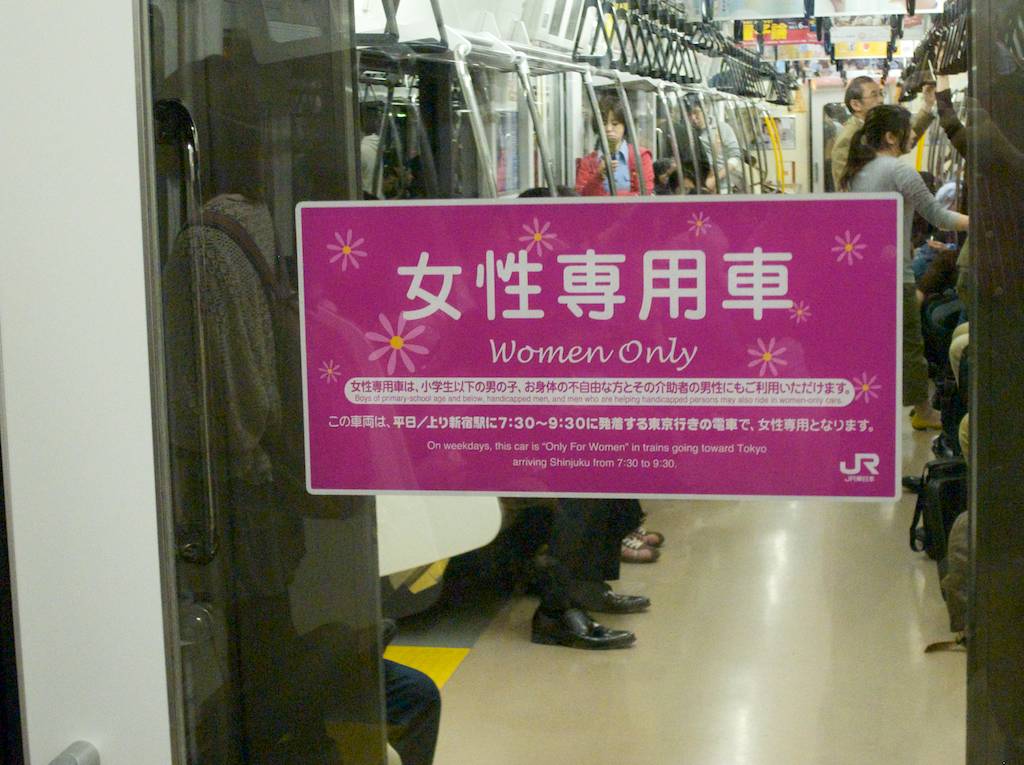
Japanese rail lines reserve some train cars for women only during rush hour. Please respect this practice.
Pink signs and other designators mark these cars. Men and women share the women-only cars between rush hours.
Luggage and Backpacks on Trains
We use trains and buses for all of our travels in Japan. This includes going to and from airports and traveling between cities. Sometimes we ride trains while carrying suitcases. Suitcases can cause problems on crowded trains during rush hour.
Entering rush hour trains with multiple suitcases or one large suitcase creates space problems for both you and other passengers. Consider your luggage volume and the times of day when planning your train travel with luggage in tow. If you carry large suitcases or more than one suitcase, you may consider traveling on trains between rush hours.
If you carry a single small suitcase plus a personal bag—a handbag or mail carrier bag—you can politely navigate rush hour train rides. Before entering the train, collapse the handle and carry your suitcase in front of you. If your suitcase also serves as a backpack remove it before entering the train. If your train provides overhead storage, use it for your luggage. Without storage available, place your luggage between your legs if standing and on your lap if sitting.
Personal Electronics on Trains
Everyone from children to great-grandparents uses mobile phones on trains in Japan—but no one talks on the phones. Passengers send and receive text messages, listen to music, play games, read books and watch movies on their electronic devices while commuting—but no one talks on the phones.
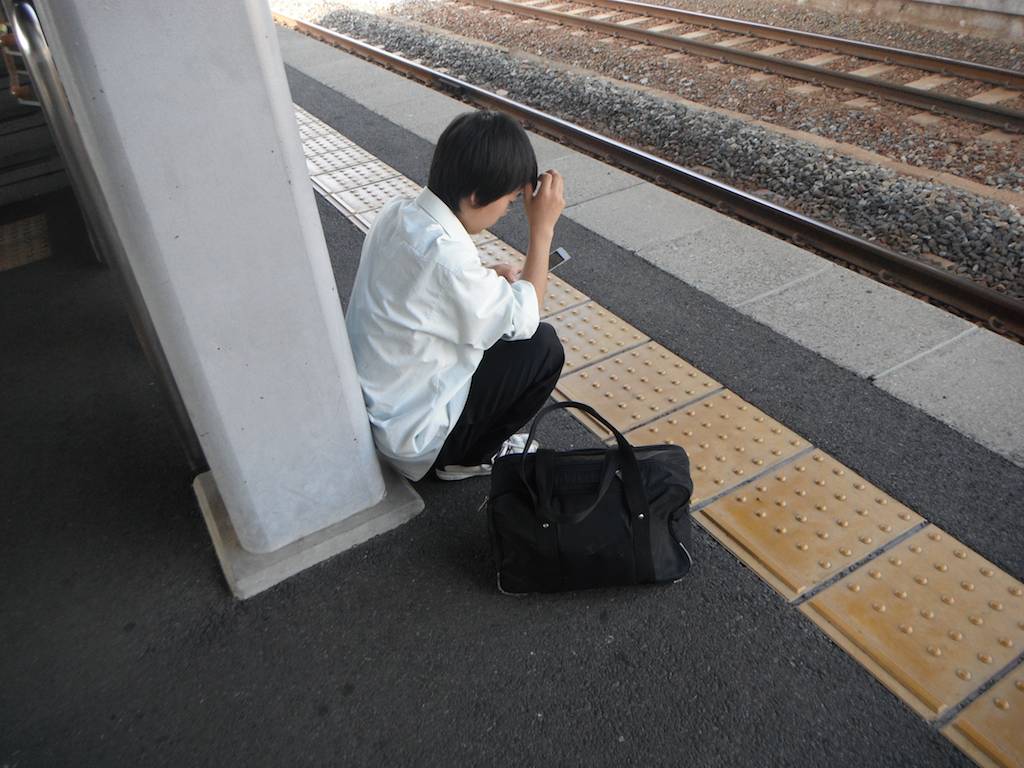
A Japanese boy quietly uses his smartphone and for waits for his train. He may listen to music, read a book or play a game, but he never talks on this phone once he enters the train.
When their electronic activity creates noise—such as with a movie, game or music—users wear earbuds or headphones and keep the volumes low enough to prevent noise spillover to even their nearest neighbors.
Cross country trains—including the Shinkansen—provide special locations at the ends of cars where you can talk on your cell phone if needed. Other than that, the train companies prohibit talking on phones.
Talking on Trains
Japanese people tend to reduce their amount of talking as crowds increase in size. They speak more softly as more people pack into a small space—at least on trains. During commuting hours in Tokyo, Osaka, Hiroshima and Sendai, you hear less and less chatter as rail cars fill up.
Keep your talking-time to a minimum in quantity and volume. Speak quietly about essentials only, such as, "We get off in two stops." And keep your decibels low. Whispering makes more noise than soft speaking.
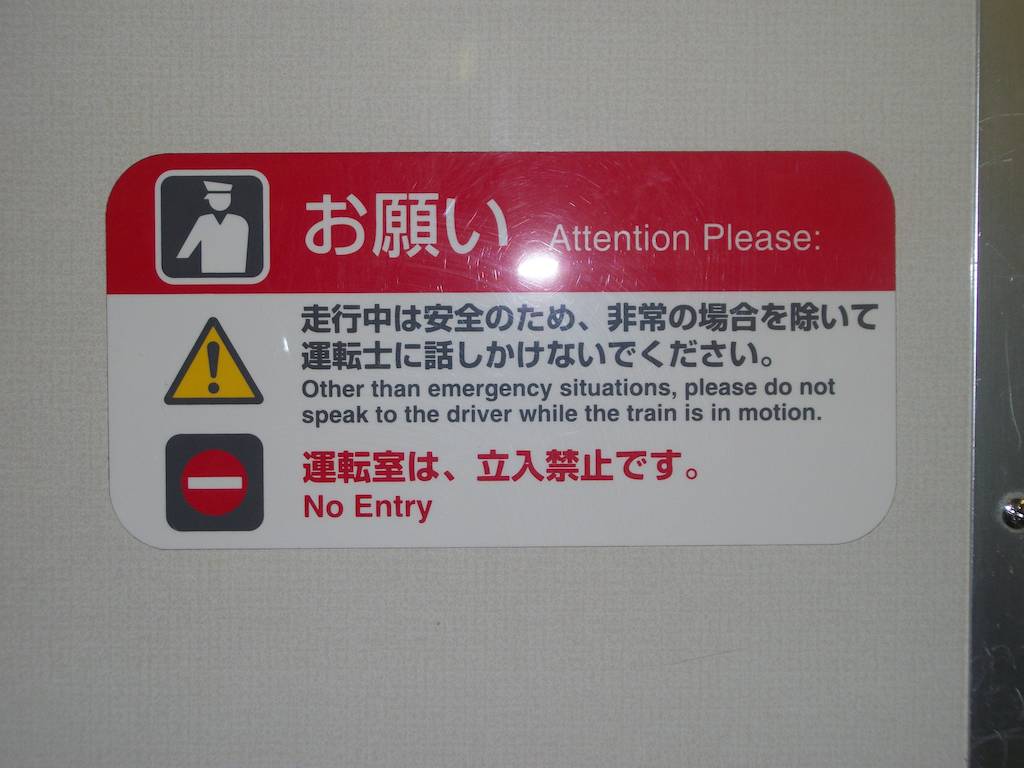
In addition to speaking quietly or not at all on Japanese trains, do not talk to the drivers.
Exceptions to silent train crowds sometimes occur on Saturday afternoons and all day on Sundays when people jabber more, but still speak very softly. Hushed rail commuting also varies among geographic locations, with Tokyo being the most noiseless, at least in our experience. However, all locations press the mute button when cars become crowded.
Smoking on Trains
Lots of people in Japan smoke. In urban settings you cannot smoke while walking on public streets.
You cannot smoke on local commuter trains. You can smoke in special cars on cross country trains.
Local train stations prohibit smoking. Shinkansen stations provide smoking rooms.
The train companies enforce their smoking regulations.
Eating on Trains
Japanese people seldom if ever walk and eat in public. They may stand next to vending machines and consume snacks, but they view walking and eating in public as bad manners.
The same applies to eating on local trains. You can sip from a water bottle, but not from a soda can or coffee cup. And you never eat. This behavior helps keep the trains clean.
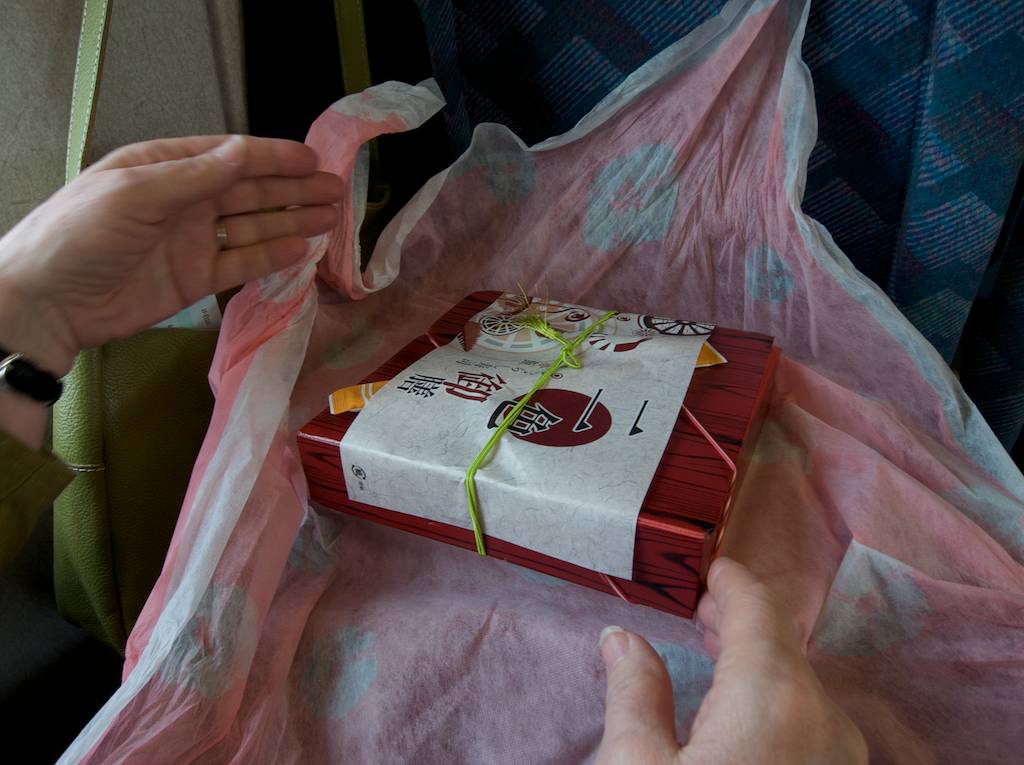
While you can eat on cross trains, you never should do so on commuter trains.
Exceptions to this are long distance cross country trains—including the Shinkansen—where you can purchase food from vendors who walk the aisles. You can also bring you own food for long trips, but make sure your meal or snack does not produce a strong smell.
Litter on Trains
Japanese trains stay clean in part because passengers never litter. They carry out what they bring in. This includes newspapers and magazines. On trains permitting you to eat, you remove all of your waste paper, boxes and cans. Some trains provide trash receptacles in the space between cars. Most train stations contain separate trash containers for plastics, metals and burnables.
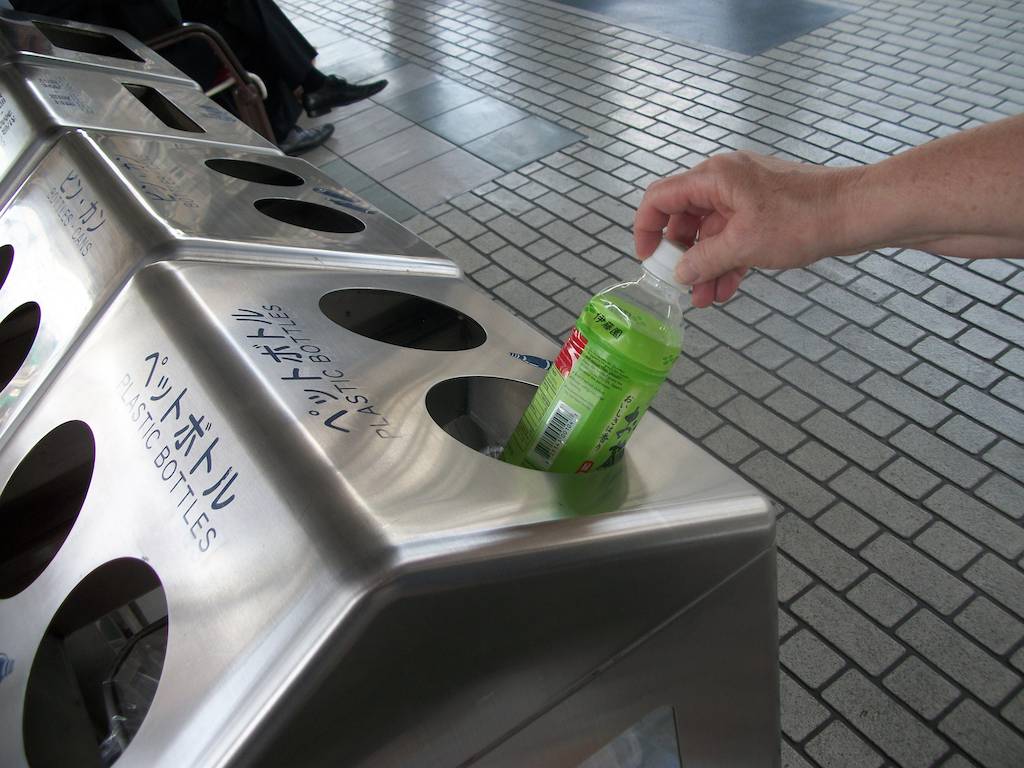
Most Japanese train stations contain trash and recycle bins for plastics, metals and burnables. Tote your own trash to the nearest bin.
Reading on Trains
Japanese people read books and newspapers on trains. While you can read a newspaper or look at a map, on crowded trains fold them to keep them out of the faces of other passengers. Take your newspaper and map with you when you leave the train.
Pardon Me, Excuse Me
Learn to say sumimasen—excuse me. Pronounce the i like an e and the e like the sound eh. Phonetically it sounds like this:
su-me-ma-sen
There is no emphasis on any syllable.
No Need to Worry
Japanese enjoy international visitors. If you make mistakes when riding trains someone helps you. Gladly accept it. Enjoy Japan.
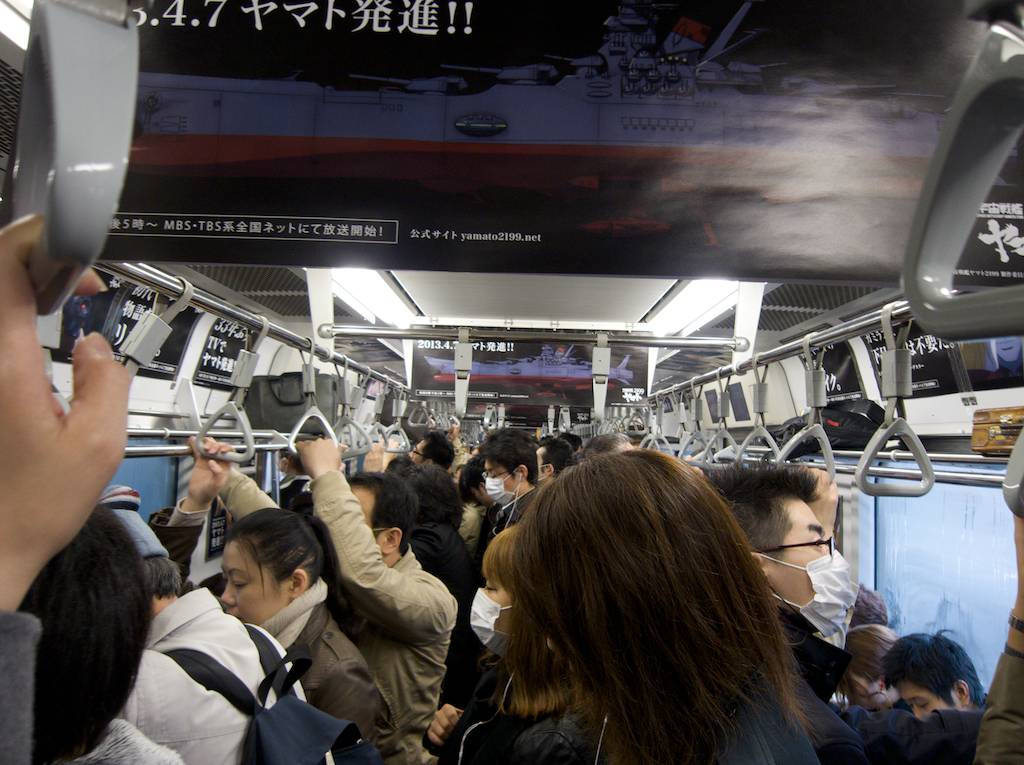
Millions of people travel commuter trains in Tokyo and other large cities daily. While they jostle against each other, crowds travel on trains in almost silence.